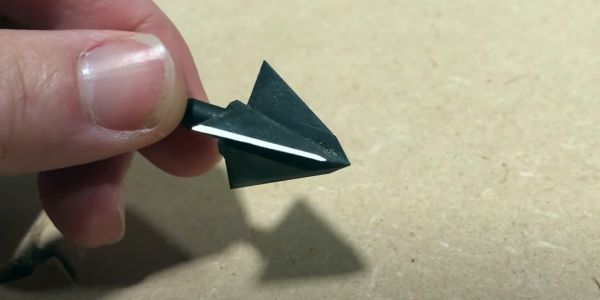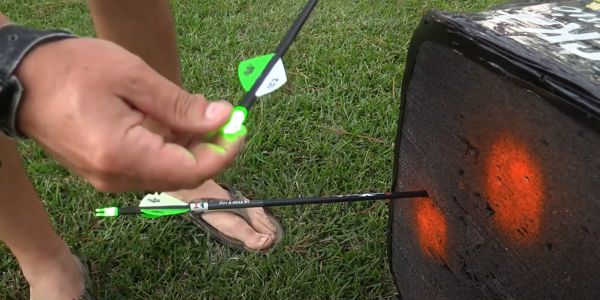In this review, I tested the Ozcut Hurricane broadheads.
Ozcut is a company outside of Australia and the time of this review, they are a relatively new company. I’ve been intrigued by these broadheads and was excited to test them out.
I have a passion for single bevel heads. So, I love it when someone comes out with a single bevel, 3-blade head.
Now, I’ve seen some other single bevel multi-blade heads that had some design flaws that prevented them from getting the full benefit of the single bevel.
However, I was intrigued by this one for a few reasons that we’ll get into right now.

My Initial Impression of the Ozcut Hurricane
First of all, the Hurricane is one piece, solid construction, and made out high-carbon steel.
The blades are really thick. And, for a single bevel to be of a benefit, they need to be thick like that.
There’s a nice tanto tip, so it’s a really durable tip and the back of the blades are sharpened. So, if it doesn’t go all the way through the animal, that head is going to stay in there doing some cutting. It also makes it easier to pull them out of your target.
So, there’s a lot about this head that I really like. I did some of my normal testing. I shot it through a couple of different layers of MDF with a rubber foam mat in the front. I also shot it at long distance. And, I shot it through some steel as well as into a cinder block. I also shot into ballistic gel to test rotation.
So, let’s see how the head holds up, how it penetrates, and how it does in this testing.
The cutting diameter on the Ozcut Hurricane broadhead is 1-1/16 inches.
-

N1 Outdoors® N-Tune™ Nock Tuning Reflective Arrow Wraps – Meat Reaper™
Price range: $18.99 through $27.99 Select options This product has multiple variants. The options may be chosen on the product page -

N1 Outdoors® N-Tune™ Nock Tuning Reflective Arrow Wraps – Sending™
Price range: $18.99 through $27.99 Select options This product has multiple variants. The options may be chosen on the product page -

N1 Outdoors® N-Tune™ Nock Tuning Reflective Arrow Wraps – Electricity (Various)
Price range: $18.99 through $27.99 Select options This product has multiple variants. The options may be chosen on the product page
Long Range Flight
The Ozcut Hurricane flew exceptionally well in the long-range shot testing. I was able to pop a balloon at 80 yards with ease.
Penetration Testing
The first penetration test was through MDF boards that had a layer of foam matting in front of them…

On the entrance into this foam mat, you can see you got a little bit of rotation from the Hurricane as evidenced by the “S-cut.”

Here, you can see the penetration through the first board right there.

And then through the second MDF board…

It bulged out of the back of the 3rd MDF board.

Upon inspection of the head after going through two layers of MDF, you can see that there are no signs of wear whatsoever. The edges maintain very well and they still shave nail.
Steel Plate Penetration Test
In the next penetration test, I shot the Ozcut Hurricane into a steel plate, followed by a layer of MDF behind it.

There’s the hole of the steel plate. It made a nice, good triangular hole and you can see again the offset blades making that extra “S-cut.”

See the head after it went through the steel plate. You can see that the edge got quite a bit nicked up and dulled. You can see it here on the edges. Overall, it did well. And the structural integrity of the head was fantastic. This has now gone through three layers of MDF and one layer of steel plate there. But, the edges did get more dinged up than I would have expected.
Cinder Block Test
Because it’s a solid machine broadhead, I shot the Hurricane into a concrete block. Not many heads have held up really well through this. the Bishop held up well, and also the Iron Will. The Tooth of the Arrow broadheads, Exodus, and A-TAC broadheads also held up quite well.
Let’s see how the Ozcut does.

Here’s the chunk (right side) that the Hurricane head took out of the concrete block. Not as big as some of the other broadheads that I’ve shot but it did penetrate and take a chunk out of it.

The Hurricane broadhead after it went into the concrete block. You can see that it got mangled quite a bit. It’s hitting concrete, so I understand that. (We are not hunting concrete. I understand that. But, I was testing it to see its overall durability and it stayed in one piece). If this did go into an animal like that, it would stay in there still cutting away but it did get mangled beyond repair going into the concrete.
Ballistic Gel Test
I was curious to see how the rotation of the Hurricane would do in a ballistic gel. So, I shot it into the ballistic gel (below). I also had some MDF behind it.
In this test, I compared it to a single bevel, 2-blade head, the Bishop Scientific Method to see how it rotates in the same medium. I also compared it to the Exodus broadheads.

You can see the penetration difference between these three heads as they all go through the gel and then stop. You see at the top, you see the Exodus that came in third and then you see the Ozcut Hurricane came in first right below that and then you see Bishop Scientific Method 2-blade right below that.

You can see the wound channel of the Ozcut in the middle. The lighter areas are where the blades are rotating around. It looks like it almost made one full rotation.

Final thoughts on the Ozcut Hurricane
So there you have it, the Ozcut Hurricane. This broadhead is a winner. There’s a lot I really like about it. It flies really well.
They say the single bevel design helps to speed up the rotation. I can’t verify that because I can’t quantify the rotation. But, I can tell you, I shoot a lot of single-bevel heads at long range and man, this one was really easy to pop balloons with. It was automatic.

I would say this is amongst the very best shooting long-range, solid fixed-blade broadheads that I’ve ever shot. I can’t think of any that fly better than this.
This head is right up there with the A-TAC. It just flies really well.
This head also penetrates really well. You can see through all those mediums and where it rotated really well through the gel. You could see that S-cut in the steel and see it starting into the wood as well.
Possible Improvements
There are two things about this head that I think they could have done differently.
What could have made it like even better is using a higher quality steel. Not that this is bad – it’s a good machined head, out of a solid chunk of carbon steel. But, when you’re using a single bevel broadhead, the rotational force and the pressure that is put on that one blade angle is intense. This calls for premium steel.
-
Sale!

N1 Outdoors® Whitetail Sugar Skull Tee (Black/Columbia Blue)
$19.00 Select options This product has multiple variants. The options may be chosen on the product page -
Sale!

N1 Outdoors® Bowhunt Oh Yeah™ Bowhunting Tee
Original price was: $26.99.$9.00Current price is: $9.00. Select options This product has multiple variants. The options may be chosen on the product page -
Sale!

N1 Outdoors® Est. 2014 Vintage Camo USA Tee
$15.00 Select options This product has multiple variants. The options may be chosen on the product page
After shooting it a few times, you can see where it gets dinged up.
In addition, it’s not super easy to find that bevel to sharpen it just right.
I also wish there was a larger cutting diameter. And, although it penetrates really well, the 1-1/16 inch cutting diameter is not the best for opening up a very big hole. I just wish it was bigger.
If it was like 1-1/8 inch, even or 1-1/4 inch, that would be awesome. If it was just a little bit bigger entrance and exit hole, I would like it even more.
So, what is this type of head great for?
As it is, this would be a great elk or moose head for lower kinetic energy setups. I think it could also be great for deer hunting, for big hogs, bears or African plains game.
So, really cool design, really cool head. Give it a look.
















































